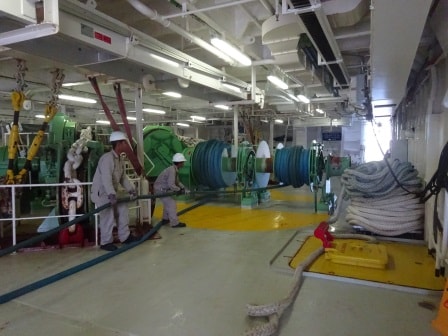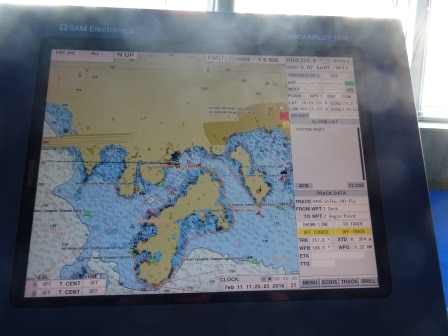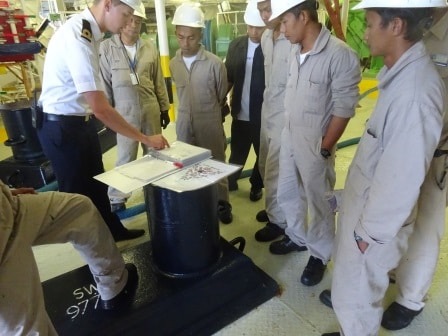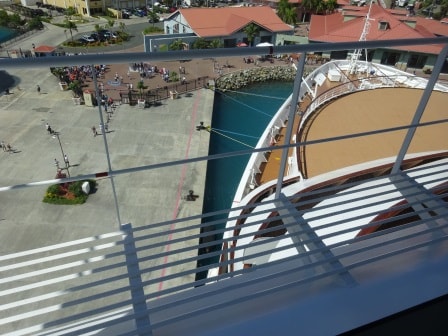To get to St. Thomas one has to sail past, or better said under, some of the islands located on the N.E crest of the Caribbean ring of islands. Not that many though only St. Maarten and the British Virgin Islands. That makes it possible to leave at 11 pm. in the evening from St.Barths and arrive in the morning at Charlotte Amalie. To give the guests sufficient sleeping time, the charterer had decreed an arrival time of 9 am. which is a really decent time to arrive. HAL ships normally arrive at 8 am. as many other ships do as otherwise it is not so easy to accommodate all the tours. But as this is more of a party cruise it has a slightly different focus. At least the Deck department did not disagree as after a late night departure it is nice not to have to get up so early.
Although the arrival time might have been different, the dock was not. The Nieuw Amsterdam docked at the regular HAL pier at Crown Bay on the Westside. As we were coming from the East we entered through East Gregory channel and that will mean that on departure we will sail out through the West channel. Nose in on arrival and a quick backing out (going astern in nautical language) and the ship is on its way again.
I went to the forward mooring deck this morning to take photos for the class for next week. We have now held classes on the R Class and the Vista Class but this is the first one on the Signature Class. Although all the mooring decks are similar nowadays, courtesy of having one building/shipyard, they keep tinkering with the lay-out in the small details. And the small details you have to know otherwise you can have big accidents.
The mooring process is an evolution of several steps. The first one is the pre-arrival meeting on the Bridge. Here the Captain will advise where he wants to park the ship. Then the Staff Captain will advise how many ropes will be used and – preferably – where they will be going. The latter does not always work as sometimes the Linesmen have a mind of their own. Then follows a discussion about the how & when. All that knowledge is taken forward by the 3rd officer and is passed on to and discussed with the Bo ‘sun and the sailors. If everybody understands what will happen, everybody can also help ensure that the evolution is executed as safely as possible.

The sailors guiding the rope on the storage drum. Before the line goes taut the sailors will step out of the way.
Putting ropes ashore is the easy part of the operation, to do it safely every time takes a bit more of doing. So apart from the meeting, safety shoes, helmets and gloves are compulsory. Then there is the safe handling of the ropes, especially when the ropes are coming taut. To keep the ship alongside the ropes have to be pulled as tightly as possible with the winch. When that happens it is the moment when the ropes comes under a lot of strain and that is the moment a rope could snap. So the word is to stand clear at all times. As that could be forgotten in the “heat of the battle” we have Snap Back Zones everywhere painted on the deck. These are yellow areas and indicate the danger zones where a rope might go when it snaps. Most of the time this will be on the edge of the hull opening where the ropes goes in or out, but if there is a weak section in the rope it can be away from the edge as well.
Nowadays we have different ropes than in the old days. Most of our ships are equipped with Marlon Ropes which are stronger but also, if they snap, just break and do not curl over the deck as a Jack out of the Box. Still the Snap Back Zones are there for a reason and everybody keeps a close eye on not standing in the yellow zones when the ropes are moving.
My photos of this morning will go in a Power Point which will be discussed with the class before they are let loose on the mooring deck to do it themselves. Again preparation helps to prevent accidents because as the golden saying goes: If you go out with 10 fingers, we would like you to come back with 10 fingers.
This was the last port of our cruise. We now have two days at sea and then we are back in Fort Lauderdale on Sunday. As we are sailing with the (Trade) wind following us, we should have a smooth ride home.




February 12, 2016 at 10:43 am
Good to have you back Capt. Let us know when you find a publisher for your book. I have writtens several books and Amazon now can publish it for you and then they sell it on Amazon and you can get copys to sell yourselfe at seminars etc. Thats how I published my latest book. I also speak in seminars and on criuse ships and I bring my book on board and sell it throught the gift shop. Cant wait to read your book.
February 22, 2016 at 7:23 pm
Concerning how the minds of the linesmen on the pier have a mind of their own, you would have had a good laugh out of audio recordings of them; at least that is what I have observed on the faces of the Captains on the bridge.
I also remember the start of using safety helmets and have photos of the crew and officers still without them. But then, I have seen many changes in the last “ten years”, such as the Captain himself inspecting the deck during the Life Boat drills …
Fortunately, just once a line snapped right below me on the pier at the stern of the Rijndam in 2008 (the Captain had an English name)